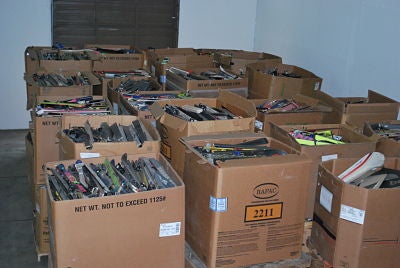
By
Last month, we of ski swaps as a great way to give new life to old skis and snowboards. But events such as swaps will never divert all old ski sticks and boots from the landfill. Fortunately, there's a concerted effort underway to turn the gear no one wants back into useful items—and maybe even back into skis and snowboards.
Last year, the (SIA) started a pilot program in which it collected unwanted skis, snowboards and boots at participating ski shops in Colorado and then put them through a multi-step recycling process in order to separate the metal and plastic materials. The plastics can then be used as feedstock for building materials and flooring (Trek lumber is a good example).
“The pilot program was highly successful,” says Greg Schneider, the recycling program manager, “we collected 100 tons of equipment.”
Schneider says that based on the number of items they were able to collect, SIA has decided to extend the program for another year. But in many ways, the hard work is just beginning. “We have two mandates,” he explains. “The recycling program has to be cost neutral and it has to be carbon neutral.”
The logistics involved in collecting and transporting the gear presents challenges both in terms of costs and carbon neutrality, so this year Schneider is evaluating some new approaches, such as collecting landfill-bound skis and snowboards leftover from ski swaps. That may result in volumes that are high enough to justify the costs and emissions required to get the material to a recycler.
But another big hurdle is finding capital to establish a dedicated recycling facility. During the first year of the trial, SIA worked with an e-waste recycler to run the gear through the seven-step process that is required to separate and grind up the materials (at the end, the plastics form a fine powder—which is referred to as flour). But the makeup of skis and snowboards differs from that of e-waste (computers and such) enough that a dedicated recycling line is required for the process to become efficient.
Schneider is hoping he'll land a grant from the state of Colorado that could provide the funds needed to establish a dedicated recycling center.
If he's successful with the project, and is able to find a way to recycle skis in a cost-effective manner while also reaching a net carbon savings—or at least neutrality—the payoff might be huge. “Once we create the [recycling] line, we could recycle all kinds of sporting goods equipment that is getting landfilled right now,” because most gear is comprised of the same basic materials.
Gear manufacturers can play an important role here, too, by working with SIA or other groups that are trying to establish recycling processes. Gear that's designed to be easily disassembled or reverse-engineered is easier and more cost-effective to recycle back into the original type of product. Plus, if manufacturers can find a way to use the recycled plastic flour as a building material for new products, they could become a major source of demand for the material.
— is a freelance writer, covering the environment, sustainability and outdoor recreation. The Good Route, her new blog for ���ϳԹ��� Online, is focused on the places where the active life and sustainability merge.